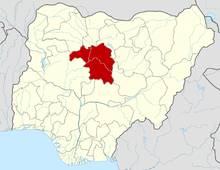Jaba, Nigeria
| Jaba, Nigeria | |
|---|---|
| LGA | |
| Country |
|
| State | Kaduna State |
| Time zone | WAT (UTC+1) |
Jaba is a Local Government Area in Kaduna State, Nigeria. Its headquarters are in the town of Kwoi (Har Kwain) in Hyam, the language of almost all the entire inhabitants of the local area. The people know themselves as the Ham and speak Hyam but are called 'Jaba' by the Hausa.
The origin of the word 'Jaba' is suggested by Koelle (1854:19) to have emerged during the contact of the people of Ham with the Hausa just about 1800s. Koelle's book records four (4) Ham youth captured during a war with the Hausa in 1846/7 and sold into slavery as revealed in an interview in 1853. According to the youth, the people are Ham or Fu Ham but labelled 'Jaaba' by the Hausa. This suggests the label, Jaba, was not accepted by the Ham at least before the year 1846–7 when the youth who gave information about the area were captured. The use of Jaba to refer to the Ham therefore may not have been more than 168 years now. Further, the meaning of the word 'Jaba' is not clear but it is suggestive of a derogatory description of the people of Ham as the house mouse/rat with the long mouth, poisonous and dangerous (Hayab, J. P. no date).
The question one would expect therefore is how this seemingly derogatory term got to be accepted by the people and utilised to describe them and even gazetted as the identity of a people or the location they are found calls for inquiry. Historically, the Ham must have lived in their current location for 40,000 years with reference to the age of the famous Nok terracotta excavated from the Ham village of Nok. In fact the town of Nok is barely four (4) kilometres from Har Kwain (Kwoi) where the local government secretariat of 'Jaba' is located. It is even shorter by a foot path via Sab Zuro, also an area believed to have been the earliest settlements of what is today 'Kwoi' town (Hayab, J. P. no date).
The word 'Kwoi' is a corruption of the term 'Kwain' ("to scratch" in Hyam). The influence of Hausa contact and its language hence has left an indelible mark on the people of Ham and their association with the name, 'Jaba'. The Ham however are not only located in 'Jaba' local government area but are found in equal number if not more in Kachia local government with sparse populations in Jema'a and Kagarko local governments. There are also Ham villages like Akaleku Sidi, Ayaragu, Masaka, Gitata and Panda with over fifty (50) years of settlement in present day Nassarawa state of Nigeria (Hayab, J. P. ongoing research).
Jaba (or should it be Ham?) local government had an area of 368 km2 and a population of 155,377 at the 2006 census. It is inhabited predominantly by Ham people, part of the people likely to have created the NOK Culture, where the first terracotta head was uncovered in West Africa during mining activities led by the British colonial government. As noted above, Nok culture is one of Africa's number one and most magnificent Art history of ancient Civilization dating back to 500 BC – 200 AD. In 1943, tin mining in the vicinity of the village of NOK near the Jos Plateau region of Nigeria, the area where Jaba local government of Kaduna state is currently located was brought to light as a terracotta head, evidence of the oldest known figurative sculpture south of the Sahara was excavated.
Although stylistically related heads, figures, animals, and pottery shards have been found in a number of Nigerian sites since that time, such works are identified by the name of the small village where the first terracotta head was discovered. A lack of extensive archaeological study that has severely limited our understanding of Nok terracotta. One of the earliest African centres of iron working and terracotta figure production, the Nok culture remains an enigma. Inhabitants of Jaba Local government could be reached by road from the southern parts from Abuja via the Nassarawa state town of Keffi or via Kafanchan, which lies roughly 40 km away from the Headquarters of the Ham in Kaduna State, Nigeria.
From the Plateau State capital, Jos, it is a journey by road to Kafanchan to Sambang Shang, Kwoi (Har Kwain), Nok, and to all other villages. From Kaduna, it is a journey through Kachia, Ngboodub, Ghikyaar and to Har Kwain. Jaba local government is in the southern part of Kaduna state and near to Jos Plateau region and Abuja, which lies in the central part of Nigeria in West Africa. As a result of natural erosion and deposition, Nok terracottas have been found to be scattered at various depths throughout the Sahel grasslands, causing difficulty in the dating and classification of the mysterious artifacts. The Ham (Jaba) has a farming population and rated one of the highest locations where ginger is produced in the world. There are a bit of administrative offices/agencies with educational institutions with the only higher institution being ECWA Pastors' Training College in Har Kwain (Kwoi). The local government capital Kwoi (Har Kwain) is the first S.I.M missionary settlement in northern Nigeria which begun in 1910.
The postal code of the area is 801.[1]
References
- ↑ "Post Offices- with map of LGA". NIPOST. Retrieved 2009-10-20.
- Koelle, S. W., Hair, P. E. H., & Dalby, D. 1854. Polyglotta Africana: or a comparative vocabulary of nearly three hundred words and phrases in more than one hundred distinct African languages.
- Hayab, J. P. No date. An on going research on the Ham social group.
Coordinates: 9°26′53″N 8°00′30″E / 9.448182°N 8.008454°E
